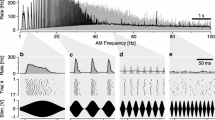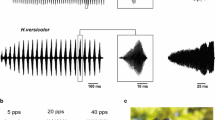Summary
-
1.
The morphology and response properties of a high-frequency, bilaterally projecting brain neuron (HBB1) is described for the cricketAcheta domestica.
-
2.
HBB1 has processes in several regions of the protocerebrum (Fig. 1), many of which overlap those of L3, an ascending prothoracic interneuron (Fig. 7).
-
3.
HBB1 is most responsive to 16-kHz sounds (Fig. 2), but only responds to suprathreshold signals with 1–3 spikes/syllable (Fig. 5). HBB1 also receives inhibitory input following excitation (Fig. 4). If the syllable period (SP) of the chirp is less than 95 ms, HBB1 only produces action potentials in response to the first syllable of the chirp, whereas a chirp having SPs greater than 160 ms induces spiking to each syllable, i.e., a low-pass filter (Figs. 3, 6).
-
4.
Several correlations exist between the input excitatory postsynaptic potentials of HBB1 and the spiking of L3. These findings are consistent with L3 providing auditory input to HBB1 (Figs. 8–10).
-
5.
The suggestion of HBB1 being involved in courtship song filtering is discussed.
Similar content being viewed by others
Abbreviations
- EPSP :
-
excitatory postsynaptic potential
- SP :
-
syllable period
References
Bacon JP, Altaian JS (1977) A silver intensification method for cobalt-filled neurons in wholemount preparations. Brain Res 138:359–363
Boyan GS (1980) Auditory neurons in the brain of a cricketGryllus bimaculatus (DeGeer). J Comp Physiol 140:81–93
Boyan GS (1981) Two-tone suppression of an identified auditory neurone in the brain of the cricketGryllus bimaculatus (DeGeer). J Comp Physiol 144:117–125
Brogan RT, Pitman RM (1981) Axonal regeneration in an identified insect motor neuron. J Physiol 319:34P-35P
Doherty JA (1985) Trade-off phenomena in calling song recognition and phonotaxis in the cricket,Gryllus bimaculatus (Orthoptera, Gryllidae). J Comp Physiol A 156:787–801
Fielden A (1960) Transmission through the last abdominal ganglion of the dragonfly nymph,Anax Imperator. J Comp Exp Biol 37:832–844
Furukawa N, Tomioka K, Yamaguchi T (1983) Functional anatomy of the musculature and innervation of the neck and thorax in the cricket,Gryllus bimaculatus. Zool Mag 92:371–385
Griffin DR (1959) Echoes of bats and men. Doubleday, New York
Huber F, Kleindienst H-U, Weber T, Thorson J (1984) Auditory behavior of the cricket III. Tracking of male calling song by surgically and developmentally one-eared females, and the curious role of the anterior tympanum. J Comp Physiol 155:725–738
Moiseff A, Pollack GS, Hoy RR (1978) Steering responses of flying crickets to sound and ultrasound: mate attraction and predator avoidance. Proc Natl Acad Sci USA 75:4052–4056
Nolen TG, Hoy RR (1984) Initiation of behavior by single neurons: the role of behavioral context. Science 226:992–994
Nolen TG, Hoy RR (1986) Phonotaxis of flying crickets. I. Attraction to the calling song and avoidance of bat-like ultrasound are discrete behaviors. J Comp Physiol A 159:423–439
Popov AV, Shuvalov VF (1977) Phonotactic behavior of crickets. J Comp Physiol 119:111–126
Schildberger K (1984) Temporal selectivity of identified auditory neurons in the cricket brain. J Comp Physiol A 155:171–185
Schildberger K (1985) Recognition of temporal patterns by identified auditory neurons in the cricket brain. In: Kalmring K, Elsner N (eds) Acoustic and vibrational communication in insects. Parey, Berlin, pp 41–49
Schmitz B, Scharstein H, Wendler G (1982) Phonotaxis inGryllus campestris L. (Orthoptera, Gryllidae). I. Mechanism of acoustic orientation in intact female crickets. J Comp Physiol 148:431–444
Stewart WW (1978) Functional connections between cells as revealed by dye-coupling with a highly fluorescent naphthalimide tracer. Cell 14:741–759
Stewart WW (1981) Lucifer dyes highly fluorescent dyes for biological tracing. Nature 292:17–21
Stout JF, McGhee RW (1988) Attractiveness of the maleAcheta domestica calling song to females. II. The relative importance of syllable period, intensity, and chirp rate. J Comp Physiol A 164:283–293
Stout JF, DeHann CH, McGhee RW (1983) Attractiveness of the maleAcheta domesticus calling song to females. I. Dependence on each of the calling song features. J Comp Physiol 153:509–521
Stout JF, Burghardt F, Atkins G (1985) The characterization and possible importance for phonotaxis of ‘L’-shaped ascending acoustic interneurons in the cricketAcheta domesticus. In: Kalmring K, Elsner N (eds) Acoustic and vibrational communication in insects. Parey, Berlin, pp 89–100
Stout JF, DeHann CH, Hall JC, Rhodes M (1988) Processing of calling songs by a L-shaped neuron in the prothoracic ganglion of the female cricket,Acheta domesticus. Physiol Entomol 13:89–101
Thorson J, Weber T, Huber F (1982) Auditory behavior of the cricket II. Simplicity of calling-song recognition inGryllus, and anomalous phonotaxis at abnormal carrier frequencies. J Comp Physiol 146:361–378
Wohlers DW, Huber F (1982) Processing of sound signals by six types of neurons in the prothoracic ganglion of the cricket,Gryllus campestris L. J Comp Physiol 146:161–173
Author information
Authors and Affiliations
Rights and permissions
About this article
Cite this article
Atkins, G., Chiba, A., Atkins, S. et al. Low-pass filtering of sound signals by a high-frequency brain neuron and its input in the cricketAcheta domestica L.. J. Comp. Physiol. 164, 269–276 (1988). https://doi.org/10.1007/BF00603957
Accepted:
Issue Date:
DOI: https://doi.org/10.1007/BF00603957




